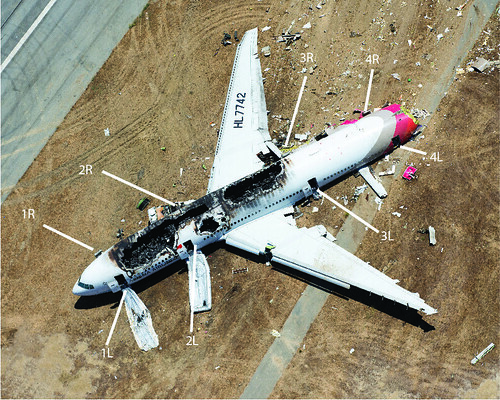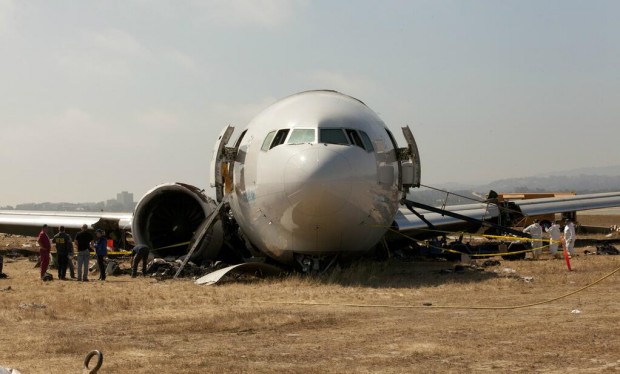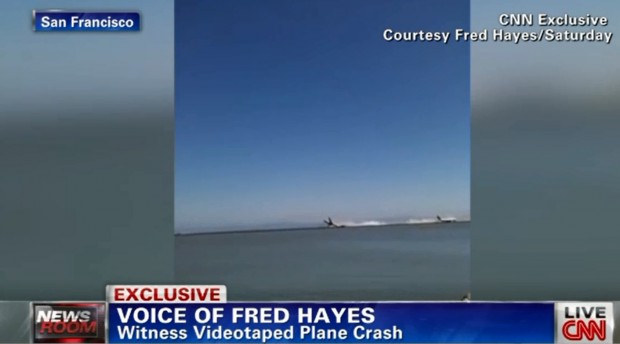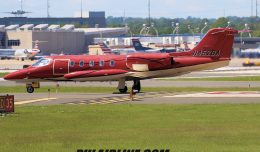UPDATE- 7-14-13
The first YouTube video shows an animation of the crash. The purple aircraft is an on-course ghost showing where the aircraft should have been had it been following the normal glidepath, versus the painted crash aircraft.
The second clip shows the same animation from inside the cockpit, comparing the views from perspective of both on-path and off-path aircraft.
UPDATE- 7-12-13
In an interview on Friday, the San Francisco police chief confirmed that one of the victims of Asiana 214 was indeed run over by a fire truck after the crash. Sadly, the girl was covered in the firefighting foam used to put out the fire, and the driver of the truck was unable to see her. However, it is still not known whether or not this was the cause of death, or if she has succumbed to her injuries prior to being run over.
Additionally, KPIX is now reporting than a third passenger has died as a result of Asiana 214, but no further details are available at this time.
UPDATE- 7-11-13
The NTSB gave their final daily briefing Thursday afternoon.
During NTSB interviews, the flying pilot reported seeing a light on approach to the runway. He said that while the aircraft was at 500ft he was observing the 3-red, 1-white PAPI lights, when he saw a light that could have been a reflection of the sun from the front of the plane. He briefly looked away, then down into the cockpit. He did not think the light affected his vision much because he could still see the instruments and speed tape. Neither of the other pilots mentioned this light during their interviews, and there was no discussion made among pilot as per the cockpit voice recorder.
Asiana has three FAA inspectors that are assigned to the airline as a Part 129 carrier (foreign air carrier). These inspectors contacted Asiana Airlines 134 times (ramp checks, interactions, etc.) over the past two years, and they reported that Asiana had been a “quiet operator with no significant issues”. As FAA inspectors, they are limited to local ramp and crew checks only, and are unable to examine flight operations in South Korea or in-flight. There are thirty-nine Part 129 airlines overseen by the FAA’s Los Angeles office.
During the final approach, one of the three flight crew members made statements about being above the glideslope, then about being on and then below the glideslope. Thirty-five seconds prior to impact, there was a 500ft callout, and immediately thereafter it was announced that the landing checklist was completed. At 18 seconds prior, there was a 200ft callout. At 9 seconds prior there was an automated 100ft callout, and immediately after was the first comment about speed status. Five second later, 3 seconds before impact, there was a call for a go-around. There was then a second call for a go-around at 1.5 seconds prior, by a crewmember that was different from the one that made the first go-around callout.
From the FDR (Flight Data Recorder) data, the engines and flight control surfaces appeared to have responded as expected to control inputs. There were no anomalies seen in the auto pilot, auto throttle or flight controls according to that FDR data.
Some part of the NTSB investigative team completed their work, and the runway “released” back to airport. With this debris began to be cleared, including rocks that came up from the seawall that had been sent several hundred feet down the runway. Cranes are being used to remove large pieces of wreckage, while smaller pieces are being removed by hand.
The aircraft fuselage is still in the grass off to the side of the runway, and inspectors are documenting the interior of the aircraft, but should done by the end of Thursday. The structure will be cut up and removed piece by piece, cutting both the fuselage and the wings. Part will be taken to a secure, local location.
There was confirmation that three flight attendants were ejected from the aircraft, still in their seats, and that two evacuation slides had deployed inside the cabin. One of the 6 hospitalized flight attendants were released.
The NTSB has only interviewed a portion of the rescue personnel interviews. From the cockpit, to back the wing, the floor was structurally sound. A firefighter reported that when he entered door 2L, the seats just aft of the door were in pristine condition (this was before the fire began and spread). As he walked further aft, he says, more and more damage became prevalent.
Cabin crew reported the exit lighting was on and that the PA system was functional for evacuation.
As for aircraft parts, the number 2 engine had spun 90 degrees counterclockwise, resting against the fuselage. The aircraft fire had begun here and spread due to the presence of this engine up against the aircraft body. The landing gear had separated cleanly from the aircraft, as designed, so as to not create a further safety hazard. Similarly, the fuel tanks were not ruptured, and there was no fuel-fed fire.
NTSB Chairman Debbie Hersman gave kudos and offered gratitude to all of the different organizations, locally and federally, that had contributed to the investigation and recovery, as well as gave other assistance, including The Red Cross, The Salvation Army and United Airlines.
A sink rate mentioned at some point on the approach as well by a member of the flight crew, time and source not provided. Korean media reported that the Relief First Officer stated this 54 seconds prior, but the NTSB has no confirmation about that specific time.
Korean media also reported that the control tower had undergone a crew change 30 seconds prior to impact. The NTSB says that final landing clearance was given at 90 second prior to landing anyway, and emergency vehicles were contacted by air traffic controllers immediately upon impact.
Emergency vehicle response, which had become a topic of discussion over the past day, is something that the NTSB is investigating. They have no conclusions or information to share at this time. They are looking at video camera footage and listening to 911 calls, as well as examining other resources pertaining to this matter.
It is also reported that, at this time, there is no evidence to reflect that an personal electronic devices had affected the performance of the aircraft.

NTSB photo of charred aircraft interior.
UPDATE- 7-10-13
On Wednesday afternoon, the NTSB once again provided an update on the investigation into the crash of Asiana 214. NTSB Chair Deborah Hersman first detailed the flight crew history leading up to the flight. On July 5th, the flying pilot was off duty at home, and had 8 hours of sleep the night before the flight. He went to the airport early to prepare for the flight, and briefed with the instructor pilot at 14:40 in Seoul, and was in the cockpit half an hour before he took command. The instructor pilot had 8 hours sleep, and reported for duty at 14:20. The pilot worked just over 4 hours together after takeoff, and were then relieved. The pair returned to the cockpit for the last 1.5 hours of the flight.
After impact, three of the four flight attendants in the rear of the aircraft were ejected. One of the flight attendants in the rear was found still inside. None of the passenger seats, however, were ejected from the aircraft. Towards the front of the aircraft at doors 1R and 2R, slides deployed inside the aircraft for unknown reasons.
At this point, a flight attendant at the front of the passenger cabin asked the flight deck crew whether or not they should evacuate, to which the crew declined. The cabin manager then made an announcement for passengers to stay in their seats. At around the same time, the flight attendant seated at door 2L could see fire outside the door and evacuation began shortly thereafter.
According to the NTSB, it was not until one and half minutes after the aircraft came to a stop, based on video evidence, that the evacuation began. An aircraft is required to be evacuated 90 seconds after the order is given, and it took that amount of time just to give the order. As to why the pilots delayed ordering an evacuation, Hersman said “we don’t know what the pilots were thinking.”
Hersman went into great detail about aircraft automation system, putting the details of extremely complex systems into simple terms. “In an airplane like the 777, we have very sohpisticed automation, but the pilots can hand fly, or fly manually, the airplane from takeoff,through cruise flight for 10 hours, to landing. They can do that without uisng any automatic if they would like. They can also use an extensive amount of automation.”
Hersman added “There are 2 pilots in the cockpit for a reason. they are there to fly, communicate, navigate, and if using automation, to monitor.”
Hersman then detailed the autothrottle system, saying “it is about power.” “Autothrottle can provide pilots speed, can help them with descending and climbing. It can do different things. It has 5 discrete modes,” Hersman added. She then gave an example, comparing it to the cruise control system in a car. “If you use cruise control in a car, you can set to to 50mph. But if the cruise control allows the cars speed to increase to 55-60-70-75, the driver needs to intervene by using brake or disconnecting cruise control. “Autothrottle is like an iphone with GPS. Its much more sophisticated [than cruise control].” “We see multiple autopilot and autothrottle modes. We need to understand what those modes were, if they were commanded by the pilots, if they were activated inadvertently, if pilots understood what the mode was doing.”
It is expected that runway 28L at SFO will be returned to the airport by the NTSB either tonight or tomorrow. At that point, the airport will be able to clean up and repair the runway for use once again.
The NTSB held their daily briefing Tuesday evening, shedding even more details into the crash, including technical details and a summary of accounts from the crew. The NTSB has determined that the post-crash fire on the inboard section of the right (no 2) engine was caused by a ruptured oil tank that leaked onto the engine, and that the thrust reverses were not activated. The NTSB has requested radar data from all Boeing 777 approaches to SFO’s runway 28L, as well as for all go-arounds that occurred on that go around since June to give baseline info trends. The flight director was switched on in right seat, but off on left seat. Auto throttle armed, and all 3 fire handles were extended after impact. Flaps were set to 30, and the speed brake lever was down and inactive. The NTSB has removed all of the slides from the aircraft, 8 doors, and 8 slides. One of the doors, door 4L, was outside of the aircraft on the ground, the other 7 are attached to the airframe.
The NTSB is interviewing the cabin crew, as well as airport operations and rescue personnel. They are looking closely at the evacuation, videos, talking to cabin crew, as well as the surviving passengers. As for the crew, 2 of the flight crew, 3 of the 4 interviews have been completed, with the 4th ongoing now. All of the crew members have been cooperative and forthright, but the information the crew provided has not yet been validated by investigators.
There were three pilots in the cockpit at the time of the crash. One pilot was in the back seated in the cabin during the approach and landing. The pilot flying, in left seat, reported that he has 9700 hours of total flight time, about 5000 hours as pilot in command. To complete his initial operating experience, he is required to have 20 flights and 60 flight hours completed. He completed 10 legs, and about 35 hours flying the 777, and was about 1/2 way through initial operating experience on the Boeing 777. He was hired in 1994, did his initial training in Florida, and is rated to fly the 737, 747, A320, and the 777. He was a ground school and simulator instructor for the Airbus A320/A321, as well as a Captain on the A320 from 2005-2013, immediately prior to the 777.
The instructor pilot, in the right seat, is also a Captain. He reported that his total flight time is 13,000 hours, about 3,000 in the 777, total pilot in command time was 10,000 hours. He reported to the NTSB that this was his first trip as an instructor pilot. This was the first time that he and the flying pilot he was instructing flew together.
The Relief 1st Officer, in the jumpseat, reported that he had 4,600 flight hours, 900-1000 hours flying the 777. He flew F-5s and F-16s in the Korean Air Force. He had previously flown to SFO several times as the pilot monitoring.
The instructor pilot stated to the NTSB that they were slightly high when they passed 1,400 feet, and set vertical speed to 1500 feet per minute. At this point, the PAPI indicators displayed 3 red 1 white light, meaning they were too low. The instructor pilot told the flying pilot to pull back, and to set speed at 137 knots. He had assumed that the auto throttles were maintaining speed. Between 500 and 200 feet, they had a lateral deviation, and were low, and were trying to correct at that point. At 200 feet, the instructor pilot noticed the 4 PAPI lights were red, airspeed was in the hatched area on the speed tape, and that auto throttles were not working as anticipated. He went to push throttles forward, but found it was already done.
Post crash, the First Officer in jumpseat described that a slide deployed inside and trapped a FA. PAX also said slides deployed inside as well.
The First Officer received medical treatment for a cracked rib. Neither of the other two pilots were admitted to hospital. Drug and alcohol testing required for part 121 carriers based in the US does not apply to foreigh crews, according to the NTSB. Part 129 refers to operators from foreign countries. Under 121, crews must be tested after an incident. None of the crew were tested in this incident.
Two of the flight attendants in the rear of the aircraft were ejected during the impact sequence. They were found down the runway and off the side, but both survived. We now also know that the main landing gear impacted seawall first, and then the tail. Pieces of the cabin are found very early on in the debris field.
“The crew is required to maintain a safe aircraft,” NTSB Chair Deborah Hersman stated at the end of the press conference, adding “We are the advocate for the traveling public.”
Update- 7-8-13
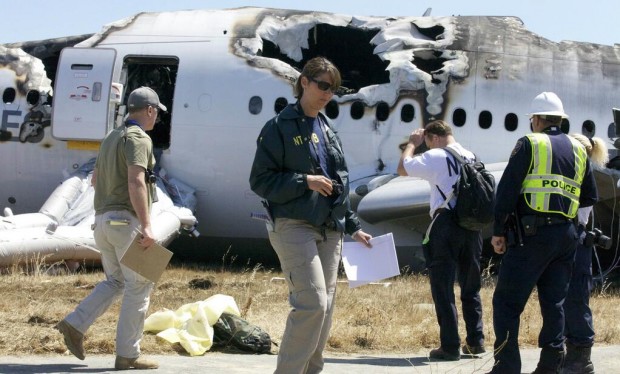
The NTSB has taken to Twitter during the Asiana 214 investigation to keep the public informed on their progress
The NTSB held another briefing Monday afternoon, giving some further insight into what happened to Asiana flight 214. The flight was cleared by NORCAL TRACON for a 17 mile straight in final approach to SFO’s runway 28L. On short final, the sequence of events occurred as following:
At 1600 feet, the autopilot was switched off. At 1400 feet, air speed was 170 knots. At 1000ft, airspeed was 149 knots, and at 500ft airspeed was 134k. At 200 feet, airspeed was 118 knots, about 16 seconds prior to impact. At 125ft, the throttles were being moved forward & airspeed was 112kts. The target airspeed for touchdown was 137 knots. At about 3 seconds before impact, the FDR recorded its lowest speed of 103 knotts. At this time, engines were at 50% power and increasing. At impact, air speed was 106 knots, a full 31 knots slower than the target speed.
A survival factors team will document over 300 seats on the aircraft to identify their condition and performance, and how they were damaged. After walking the crash scene, the NTSB has determined that the lower portion of the tail cone is in the rocks at the sea wall, and that there was a significant piece of the tail in the water. Additional aircraft parts in the water are visible in the water at low tide. The right engine is tucked in adjacent to the wing root of the aircraft, and the left engine was “liberated” from the aircraft.
Deborah Hersman, Chair of the NTSB, also put to rest rumors that the aircraft entered a steep descent of 4,000 feet per minute, as reviewed radar data does not confirm this. As for the possibility of a passenger being struck by fire rescue equipment, that investigation is ongoing and they can not confirm anything at this point.
There are currently 20 NTSB investigators on the ground, led by Bill English. The NTSB will provide another update on Tuesday.
Update- 7-7-13 6:30pm
The NTSB has just released several detailed photos of the crash scene, including shots of the interior showing extreme damage. The tweets were sent without any commentary.
— NTSB (@NTSB) July 7, 2013
— NTSB (@NTSB) July 7, 2013
— NTSB (@NTSB) July 7, 2013
— NTSB (@NTSB) July 7, 2013
— NTSB (@NTSB) July 7, 2013
— NTSB (@NTSB) July 7, 2013
UPDATE- 7-7-13 5pm
The NTSB on Sunday evening held a press conference, detailing some preliminary details obtained by the fight data recorder and cockpit voice recorder.
CVR and FDR contain good data. Prelim data shows CVR recorded 2 hours of data. During approach, the throttle were at idle and airspeed was “significantly” slowed below target airspeed of 137 kts, “and we’re not talking about a few knots,” said Deborah Hersman, chair of the NTSB. 7 seconds prior to impact, a call to increase speed. At 4 seconds before impact, the stick shaker, which notified pilots that a stall is imminent by literally shaking the control stick, activated. The throttles were advanced a few seconds before impact, and engines responded properly. At about 1.5 seconds before impact, the crew called for a go-around, but it was too late. The flight data recorder shows that the flaps were properly set to 30 degrees, and the landing gear was down.
The crew will be interviewed over the next several days, and more details will emerge. At the time of the incident, the ILS system at SFO was out of service, as was the glide slope. However, that information was contained in NOTAMs, so this would have been known by the crew. Precision approach path indicators lights on runway 28L were damaged in the crash sequence, but were in service before the crash.
Just before the press conference, video surfaced on CNN that shows the approach and impact, and it tells quite a story. Check out the video here. There were no reports of wind shear, or any adverse weather conditions at the time of the crash.
When asked about possible pilot error as the cause of the crash, Deborah Hersman responded “I will tell you everything is on the table right now. It is too early to rule anything out. I ask you to report the facts, and make sure the public is well informed. We will not speculate, and we will not draw conclusions.”
ORIGINAL UPDATE
Asiana Flight 214 from Incheon, South Korea, a 777-200ER (registered HL7742) has crash-landed at San Francisco International Airport just before noon on Saturday.
Witnesses are reporting that the aircraft made a hard landing on runway 28L, possibly falling short of the runway. for unknown reasons, leading to the crash and a major fire. The aircraft experienced destruction of the landing gear, along with separation of both engines and both the tail and tail cone. The tail section seems to have made contact and separated from the aircraft at rocky shoreline prior to or at the beginning of the runway, far short of the intended touchdown area.
After earlier reported that all 307 on board survived, it is now coming in that 2 people have died in the crash, and there are multiple injuries, including burns. Photos from the scene indicate that evacuation via emergency slides did take place.
San Francisco Airport is closed until further notice.

Asiana 777-200LR (reg. HL7742), seen here in better days. (Photo by Mark Szemberski)

The flight path of Asian Flight 214 from Incheon to San Francisco.
We will be updating as more details develop…



